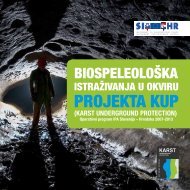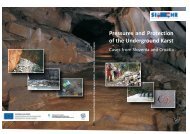prvi hrvatski speleološki kongres - KARST underground protection
prvi hrvatski speleološki kongres - KARST underground protection
prvi hrvatski speleološki kongres - KARST underground protection
Create successful ePaper yourself
Turn your PDF publications into a flip-book with our unique Google optimized e-Paper software.
very intense limestone erosion which is the main factor in the process of formation of<br />
these objects. Erosion activity lead to formation of large amount of <strong>underground</strong> karst<br />
forms.<br />
The most famous explorers that had been working on the area of Montenegro<br />
were A.Grund, A.Penk, K. Abolson and J.Cvijic. A more complete and wider research<br />
on speleological objects in Montenegro started after II World War i.e. with<br />
establishment of Speleological Association of Yugoslavia 1952., which organized<br />
those activities all over the country. In Montenegro speleological organization was<br />
established around 1960. when the continuous work on <strong>underground</strong> objects started.<br />
The most important result in speleological explorations were made in last 20 years.<br />
Most of the exploratory activities were conducted on the mountain massif of<br />
Durmitor, where the deepest shaft of Balkans was discovered. Because it has a large<br />
number of speleological objects, the Durmitor national park was named a<br />
speleological Eldorado. Detailed explorations were made in massifs of Lovcen and<br />
Orjen, surroundings of the Skadar lake and on the outskirts of Niksic field.<br />
Conducting hydro-geological explorations on the Pester plateau, speleologists have<br />
found probably the longest cave in this part of Balkans, in Djalovica gorge (near<br />
Bijelo Polje). Until now, 16 km of cave canals have been explored.<br />
In those explorations, significant place belonged to speleologists from clubs<br />
from Belgrade(Proteus, ASAK, SOB), Zagreb (DISKF). Sarajevo and explorers teams<br />
from Poland, United Kingdom and France.<br />
The significance of speleology and it's results are multiple. Areas that lay on<br />
limestone basis are known as areas with no fresh water streams. This led to formation<br />
of large deserted areas due to lack of humidity. The population of those areas is very<br />
small, because nature circumstances do not give basic life sustaining conditions. The<br />
importance of speleological research in direction of discovering <strong>underground</strong> water<br />
basins in this area is priceless. Those basins would probably return life to many areas<br />
and enable development of agriculture. Important results of speleological explorations<br />
were made during the exploration of water intake for means of city water supply,<br />
determining basin areas for means of building artificial lakes, for power plants etc. In<br />
Montenegro at the moment there is no cave that has been adapted for tourist visits<br />
although there is large number of discovered caves with extraordinary cave ornaments<br />
during the years of research and exploration.<br />
Long activity of limestone erosion caused formation of breathtaking cave<br />
ornaments. The beauty of those can often be compared with famous artwork. In<br />
speleological objects in Montenegro almost all ornaments known: stalactites,<br />
stalagmites, draperies, malts, bigrenic tub, helectites, hieroglyph, cave milk, cave<br />
rose.<br />
Underground life is fairly developed but the most famous inhabitants of those<br />
areas are of course bat and Proteus. Proteus has not yet been found in Montenegro,<br />
although it has been found in Dinarides limestone area to the west of Montenegro.<br />
There are many tasks to cope with for Montenegrin karst <strong>underground</strong>, despite<br />
the fact certain parts of Montenegro were subject of extended research. Research<br />
needs to be continued in areas of Durmitor, Lovcen, Orjen, Mountain range of<br />
Moraca, Djalovica gorge. Also, new fields for research need to be opened for<br />
explorers in unexplored areas of Rumija, Prokletije, Komovi, Ljubisnja. A separate<br />
part are speleological objects in zone of “Morsko dobro” i.e. underwater, which need<br />
to be subject of future detailed research. Also, one of main tasks is to initiate activities<br />
in direction of making legislative which will enable level of <strong>protection</strong> of<br />
speleological objects as it is in surrounding countries.<br />
70










